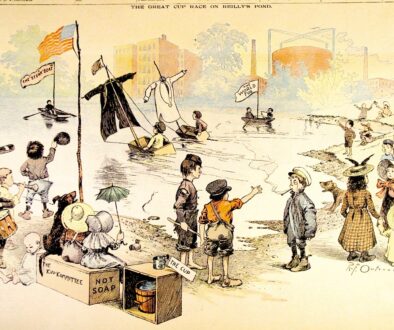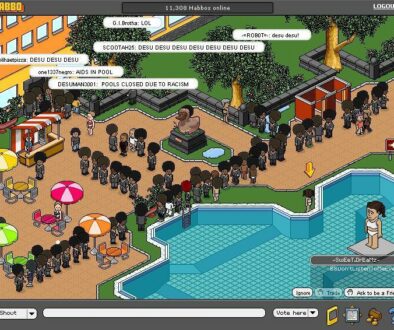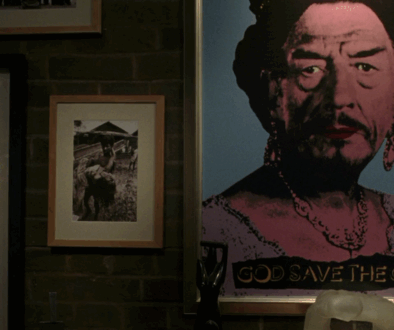“The placques that explained who they were also told me that the majority of them had murdered their families and sold their bodies to anatomy. It was then that the word anatomy garnered its own edge of horror for me. I did not know what anatomy was. I knew only that anatomy made people kill their children.” – Neil Gaiman
 |
Figure 396: With Moore’s second issue,
he announced himself unequivocally
as one of the most important and creative
figures in comics. |
Saga of the Swamp Thing #21, also known as “The Anatomy Lesson,” is a regular on critics’ lists of the best single issues in the history of comics. This is entirely understandable. Upon release it was a revelation to the handful of readers who were actually buying Saga of the Swamp Thing, and its impact upon them (and upon DC editorial, who began aggressively promoting the title in the wake of Moore’s early issues) is largely responsible for how Moore took a book that was near cancellation and turned it into one of the gems of DC’s line. Beyond that, however, “The Anatomy Lesson” is simply a brilliant comic. Even over thirty years later, when almost every trick and device Moore employs has become every bit as much of a comic book cliche as the twenty-year-old Stan Lee style that Moore championed moving on from, the comic buzzes with power, its sense of freshness and originality undimmed by its countless imitators. It is visibly and transparently a work of genius – a shot across the bow at the precise moment in Moore’s career where he most needed to demonstrate just how good he was.
Under the hood, of course, “The Anatomy Lesson” is simply “A Rag, a Bone, a Hank of Hair” wrapped in a Future Shock. Moore is in many ways straightforwardly repeating the start of his run on Captain Britain here, killing the main character in an initial story focused on wrapping up inherited plot lines and then reintroducing him in his second story. Like “A Rag, a Bone, a Hank of Hair,” “The Anatomy Lesson” spends much of its time paralleling a forensic and clinical analysis of the main character’s dead body with an account of the character’s origin and basic concept. But there is a crucial, albeit subtle difference. “A Rag, a Bone, a Hank of Hair” focuses on recapping the whole of Captain Britain’s history up to that point, telling the story of several distinct runs and attempting to reconcile them into a coherent history. “The Anatomy Lesson,” on the other hand, is focused almost entirely on dissecting the events of Wein and Wrightson’s 1972 Swamp Thing #1.
 |
Figure 397: The last page of “The Anatomy
Lesson.” (Written by Alan Moore, art by
Steve Bissette, Rick Veitch, and John
Totleben, from Saga of the Swamp Thing
#21, 1983) |
This leads towards the issue’s other major antecedent in Moore’s work – his lengthy tenure writing twist ending stories for 2000 AD (a form, it should be noted, that has its roots in the EC horror comics that House of Secrets emulated. Like many of Moore’s Future Shocks and Time Twisters, “The Anatomy Lesson” favors an elliptical structure. It starts and ends with a character, Jason Woodrue standing in his Washington apartment, with the first and last pages being structural mirrors of each other – a backdrop in which Woodrue’s face is cut up into multiple small square panels and a trapezoidal set of panels that overlap these panels depicting Woodrue in long shot, staring out his apartment windows, which are cut into a set of small, square frames so that the square panels underneath serve not only as frames of a comic but as a literal depiction of Woodrue’s face from outside of his window. To the right of each page is a vertical stack of panels that are arranged like the window panels featuring Woodrue’s face, but that depict another event. The first and last lines of the comic are identical: “it’s raining in Washington tonight.”
 |
Figure 398: The first page of “The Anatomy
Lesson,” with a structure paralleling the
last. (Written by Alan Moore, art by
Steve Bissette, Rick Veitch, and John Totleben,
from Saga of the Swamp Thing #21, 1983) |
As with Moore’s elliptical Future Shocks, however, the point is not so much the fact that the beginning and end of the story match, but rather that upon reaching the end of the story and revisiting its first image the reader is in a profoundly different place due to some surprise revelation. As is typical of the structure, the first page ends by setting up a mystery, the solution to which will hinge on the surprise. In this case, Woodrue describes “the old man” (who turns out to be Sunderland, the villainous corporate leader who spent most of Pasko’s run trying to kidnap Swamp Thing) and imagining him “pounding on the glass right about now.” Woodrue muses on whether there will be blood. “I like to imagine so,” he admits. “Yes, I rather think there will be blood. Lots of blood. Blood in extraordinary quantities.” This monologue juxtaposes the vertical strip of panels on the page’s lower level, which also show a view of a man through a window, specifically one pressing desperately against the glass as, over the course of three panels, the glass is steadily covered with blood.
 |
Figure 399: Swamp Thing’s first appearance within “The
Anatomy Lesson,” as a bullet-ridden corpse. (Written by
Alan Moore, art by Steve Bissette, Rick Veitch and John
Totleben. From Saga of the Swamp Thing #21, 1983) |
This sequence raises a number of questions such as “who is this man” and “why is he being brutally murdered,” the answers to which will presumably fill the remaining twenty-two pages. Having set up the mystery, then, the comic proceeds to a flashback that makes up the bulk of those pages. Despite the fact that the issue was not promoted as a jumping on point for new readers, and would in reality only inherit the dwindling audience that existed for the comic, Moore is careful to structure this sequence to work for new readers. It is not until the third page that Swamp Thing himself is introduced, and then only as the bullet-ridden corpse seen at the end of “Loose Ends.” Like the image of the man dying against the glass, Swamp Thing is presented as a mystery – a problem to solve. In this case, the problem does not appear to be “who is this person,” but rather a more metafictional problem – how is this comic going to deal with the fact that its main character is dead?
 |
Figure 400: Jason Woodrue ponders the impossible anatomy
of a vegetable man. (Written by Alan Moore, art by Steve
Bissette, Rick Veitch, and John Totleben. From Saga of the
Swamp Thing #21, 1983) |
And yet Moore answers this, in many ways, the wrong way round, instead spending the next ten pages instead carefully analyzing the question of who Swamp Thing is, going over the origin story repeatedly. This is structured as a series of rhetorical questions and answers. Initially the mystery is why Alec Holland became the Swamp Thing when nobody else who had been exposed to the famed bio-restorative formula was turned into a plant. Woodrue examines Swamp Thing’s body closely, discovering that he has human-like organs inside of him, but that these organs are just vegetable matter and can’t possibly function. Finally, after a brief bit of exposition about planarian worms, which were at the time in vogue in popular science news due to a study, ultimately revealed to be fatally flawed, in which the worms were trained to run a maze, then ground up and fed to other worms who seemed to then learn to run the maze faster, Moore gets around to dropping his major twist: in fact Alec Holland was killed by the explosion, and his corpse was flung into the swamp where the bio-restorative formula caused the plants that fed on Holland’s decomposing body to absorb his consciousness. As Moore explains it, “we thought that the Swamp Thing was Alec Holland, somehow transformed into a plant. It wasn’t. It was a plant that thought it was Alec Holland!”
 |
| Figure 401: A planarian. |
From this revelation at the halfway point of the issue Moore begins working backwards towards his opening, explaining why Woodrue is standing in his apartment thinking about the death of the old man who hired him to figure all of this out. Woodrue explains how the old man immediately and cruelly fired him, declaring that he had no further use for him and that “there are others who can be paid to see the work through to its conclusion,” and that Woodrue proceeded to sabotage the building’s security systems, locking all of the doors and turning off the freezer unit in which Swamp Thing was stored.
 |
Figure 402: Bissette and Totleben used the
occasion of Swamp Thing’s resurrection to
debut their new and more vegetative design for
the character. (Written by Alan Moore, art by
Steve Bissette, Rick Veitch, and John Totleben,
from Saga of the Swamp Thing #21, 1983) |
This leads to the issue’s second, and more bleakly funny twist, the solution to the story’s page three mystery: how is the comic going to handle the fact that its main character is dead? The answer, it finally turns out, is that by reexamining and altering the nature of the character’s origin, Moore also quietly and without fanfare changed the nature of his death. As Woodrue reflects, the old man “should have let me finish. He should have listened. Then I’d have been able to explain the most important thing of all to him. I’d have been able to explain that you can’t kill a vegetable by shooting it in the head.” And indeed, the old man hasn’t, and Swamp Thing rises, reads the report that reveals that he is genuinely a monster with no hope of ever regaining a humanity he never had, and, in fury, kills the old man. And so the comic returns to its initial image, the main character restored and the order of things completely upended, an immaculate and intriguing slate for Moore to construct new stories upon.
 |
Figure 403: Swamp Thing, shattered
by the realization that he was never
human, sinks back into the swamp.
(Written by Alan Moore, art by Steve
Bissette and John Totleben, from
Saga of the Swamp Thing #22,1983) |
The first of these new stories is a three-part story that further explores the character of Jason Woodrue. Woodrue is not merely a plant scientist, as “The Anatomy Lesson” makes clear, but rather the human identity of the Floronic Man, a minor plant-based villain within the DC Universe. Picking up several months after “The Anatomy Lesson,” this arc features Woodrue studying Swamp Thing as he reacts to the revelations of “The Anatomy Lesson.” At the start, Swamp Thing is not in a good way – as Woodrue explains it to Abby and Matt, “he’s given up on being human. It got to be too much for him and he had to let it go. He’s withdrawn. He’s a vegetable. He hasn’t moved in a fortnight. He’s put down taproots and stopped pretending to breathe.” Meanwhile, in sequences that go within Swamp Thing’s mind, he has a series of visions in which he steadily abandons the vestiges of his humanity, abandoning his love for Linda Holland, coming upon a bunch of worms feasting upon the corpse of Alec Holland and leaving only his humanity for Swamp Thing to eat, and finally opting to discard the last of his humanity, symbolically represented as a skull and a few vertebrae imploring Swamp Thing to “get up! C’mon! Get moving! This is the human race! You have to keep running or you get disqualified!”
 |
Figure 404: The Floronic Man explains
his vision of a world without animals.
(Written by Alan Moore, art by Steve
Bissette and John Totleben, from Saga
of the Swamp Thing #23, 1984) |
Meanwhile, the Floronic Man executes a scheme to commune with the world of plants into which Swamp Thing is sinking, an experience that drives him mad and leads him to embark upon an elaborate scheme of the sort generally associated with super-villains. He begins in a town of 559 people called Lacroix, where he seals the population within their houses and begins allowing the vegetation to grow wild. “In almost all of the houses,” Moore’s narration explains, “there were one or more potted plants. These began to accelerate their photosynthetic processes, pumping out pure oxygen at an alarming rate. As they became hyperoxygenated, the people within the houses grew excited and nervous without knowing why. At 2:15, someone lit a cigarette,” the result of which was the incineration of the entire town. Woodrue explains that this is the beginning of a plan to eradicate the entirety of the animal population of the planet to create “another green world, as there was at the beginning, before the beasts crawled up out of the oceans. Those long, green centuries where no bird sang, where no dog barked, where there was no noise! Where there was no screaming meat!!”
 |
Figure 405: Swamp Thing greets
the sun, at home in his swamp, at
peace with his vegetable nature.
(Written by Alan Moore, art by Steve
Bissette and John Totleben, from Saga
of the Swamp Thing #24, 1984) |
The effect of Woodrue’s scheme to create so much oxygen that animals die out however, is traumatic to the Green, where Swamp Thing now resides, and, between his fury at Woodrue’s tainting of the place Swamp Thing retreated to and the terrified screams of Abby Cable as she is attacked by plants, Swamp Thing returns to confront Woodrue. The core of this confrontation is an argument between Woodrue and Swamp Thing, in which Woodrue rants more about how he is saving the planet from the animals that are destroying it, while Swamp Thing argues that the death and destruction wrought by Woodrue is itself “the way of man.” The argument concludes when Swamp Thing confronts Woodrue with the question of who “will change the oxygen back into the gasses that we need to survive when all the men and animals are dead,” at which point Woodrue’s sense of communion with the world of plants falters, and he cracks and runs away. Abby summarizes this, saying that “he realized that the plants couldn’t survive without man, and so the plants backed down.” Swamp Thing concurs, but asks, “will your people do as much?” But however much Swamp Thing may consider himself to be separate from Abby’s people, he is animate now, and accepts that his place is not to simply sink into the green, but to live in the swamps, experiencing the vibrant ecosystem, and the arc ends with a splash page of Swamp Thing standing, arms spread, greeting the rising sun. [continued]















July 25, 2014 @ 3:57 am
Great post. I remember reading this sequence as a kid and having my mind utterly blown.
The splash page logo is, of course, an homage to the poster designed by Saul Bass for the 1959 film "Anatomy of a Murder."
July 25, 2014 @ 6:00 am
I first learned the term "retcon" in reference to this story. I'm sure the idea of retroactive changes to continuity has been around for years before Moore, but "The Anatomy Lesson" is almost the platonic ideal of the story.
July 25, 2014 @ 6:09 am
Being around when these came out and reading them as they dropped was like being hit by a revelatory thunderbolt. There isn't a single misstep in any of these issues, and every time you turn around you get hit by something brilliant-the pages in the last issue where the Justice League debates what to do about Woodrue were so unlike what anyone else was doing with superheroes and so defining in so few pages that lesser writers are still mining it to this day. I discovered a local comics store around the time Moore took over Swamp Thing, so I'm fairly sentimental about the issues for that reason, but they're really, really good to boot.
Moore became far better at his craft as time went on, but I am not sure he ever matched the sheer, raw power and potential energy of his first year on Swamp Thing ever again. Maybe the Toteleben issues of Miracleman matched these. (Watchmen is a wholly different sort of narrative construct to me in terms of narrative energy.)
July 25, 2014 @ 6:59 am
No wonder I ended up studying ecological philosophy.
July 25, 2014 @ 7:17 am
Like other commenters, I was utterly thunderstruck by these issues when I first read them (I was drawn in by the aggressive marketing you mentioned, seeing ads in other books trumpeting how good "The Anatomy Lesson" and following issues were, I soon caught up on what I missed). Moore's writing and Bissette and Totleben's art were a perfectly creepy-crawly match. Not only did Moore turn Swampy from a c-lister to a can't miss title, he took a whole host of minor and poorly-used DC fringe characters (Woodrue here, later on the Demon, the Phantom Stranger and the Spectre) and gave them compelling characterizations (and created the blueprint for what would eventually become Vertigo). It's by far his most important 80s work, IMO.
July 25, 2014 @ 2:28 pm
FYI-
Warren Ellis, circa 2006, on Genre Postmodernism, Alan Moore, and SWAMP THING.
One of the central tenets of postmodernism is questioning the discourse; taking a piece or form of fiction and running it through psychological and theoretical interrogation. Alan Moore's SWAMP THING is a prime example: it takes the ur-text, the original Wein/Wrightson SWAMP THING, and works it over with a cosh in a small room. It can in fact be viewed as a stack of queries. How does human intelligence become inculcated in plant matter? What are the psychological implications? What does that body feel like? How does it move? How does it resolve sex? The hoary old plotlines of the genre the original work resided in, the horror story, are dragged out not only to be questioned themselves, but also to provide an illusory plot structure to the real work of the book. The plots are of secondary importance to the power of revelation. SWAMP THING, MARVELMAN, V FOR VENDETTA and, to a lesser extent, WATCHMEN are discursive, almost rhetorical works. People still bitch even today about the old-style sci-fi climactive trigger-event of the final chapter, the dropping of the monster-bomb on New York City to save the world. But it fits entirely within the genre Alan (and Dave) are studying.
But the power of the first three works, at least in their early volumes, is in the revelation. Go and re-read the barnstorming concluding chapter of V FOR VENDETTA Book One, where Eric Finch puts it all together and lays it out. There's a similar sequence in MARVELMAN, where the protagonist takes a Heart Of Darkness journey to the bunker where all the secrets are, and is presented with the sum total of Alan's questions about the original text.
Postmodernism is, to a great extent, remix art. It needs those original texts to key off of. It's about the sparks struck by the collision of the original text and the modern perception of it. It sometimes comes off as "Tutti Frutti" being played on a synth using only a sample of someone farting. Someone once said of the TV writer Dennis Potter that his using all those old songs in his work was clever, but was it as clever as writing those songs in the first place?
Alan's best work to date, FROM HELL, avoids that accusation by applying his method to history. But it IS the same method, the same approach. He simply applies his interrogatory intelligence to the historical record, instead of a work of admitted fiction….
July 25, 2014 @ 4:11 pm
Jane – "No wonder I ended up studying ecological philosophy."
I have studied ecological philosophy and wish we had read Swamp Thing as part of that! We read a bunch of other literature and this would have been very cool.
July 26, 2014 @ 5:40 am
Late, I know, but I just wanted to say I missed "The Anatomy Lesson" but picked up on the buzz and joined with the next issue. This was gripping, story and art working hand in hand, and I also received a present the following issue with a story named after a Brian Eno album. Lovely. This was the most sucked into a comic I'd been for ages, eclipsing even my initial reaction to Marvelman in Warrior #1.
July 29, 2014 @ 4:06 pm
Okay, I just ordered this and the collection of Wein's originals. My food & gas budget can take one more for the team.
February 18, 2015 @ 11:12 pm
No wonder I ended up studying Forest School and became and outdoor educator/eco-therapist.
February 18, 2015 @ 11:19 pm
Wow.Thanks Phil. These storylines absolutely blew my mind and heart in my late teens. They pretty much changed and rocked my world, opening up new inspiration. I got into Swamp Thing in a circuitous way, having first picked up issue 1 of Hellblazer as I was caught by the beautiful artwork on the cover (Dave McKean – knew his work already). From there I got caught by Constantine's enigmatic character and there was a point (can't recall issues) where the storyline converged with Swamp Thing, during the Veitch run I think.
I thought, wow, 'who's that?' and found what I could of Moore's Swampy work (trade paperbacks, B&W), caught up on it as I bought up new monthly issues. Bissette and Totleben's artwork was and still is a major influence on me and I love where their work goes. Beautiful.